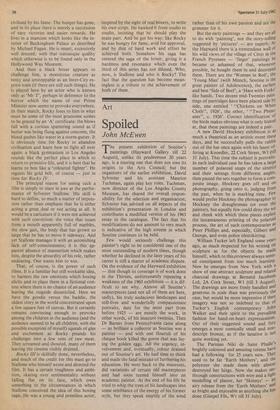Art
Spoiled
John McEwen
The present exhibition of Soutine's paintings (Hayward Gallery till 22 August), unlike its predecessor 20 years ago, is a touring one that does not owe its origins to the Arts Council; but the organisers of the earlier exhibition, David Sylvester and his assistant Maurice Tuchman, again play key roles. Tuchman, now director of the Los Angeles County Museum, has shared the overall respon- sibility for the selection and organisation; Sylvester has advised on all aspects of the exhibition's presentation in London and contributes a modified version of his 1963 essay to the catalogue. The fact that his modifications do not amount to very much is indicative of the high esteem in which Soutine continues to be held.
Few would seriously challenge this painter's right to be considered one of the most outstanding of modern times, though whether he declined in the later years of his career is still a matter of academic dispute. On the evidence of the Hayward exhibition — thin though its coverage is of work done in the Thirties, unfortunately repeating a weakness of the 1963 exhibition — it is dif- ficult to see why. Almost all Soutine's masterpieces (and not all of them are here, sadly), his truly audacious landscapes and still-lives and wonderfully compassionate portraits, date for the most part from before 1925 — are mostly the work, in other words, of his insecure twenties. Then Dr Barnes from Pennsylvania came along — as brilliant a collector as Soutine was a painter — and with one flourish of his cheque book killed the goose that was lay- ing the golden eggs. All the urgency, in- volvement and, eventually, colour drained out of Soutine's art. He had time to think and made the fatal mistake of furthering his education. He went back to the museums, did variations of certain old masterpieces and had soon turned himself into an academic painter. At the end of his life he tried to whip the trees of his landscapes into some semblance of the energy of his former style, but they speak emptily of the wind rather than of his own passion and are the grimmer for it.
But the early paintings — and they areal' to do with 'painting', not the story-telling suggested by 'pictures' — are superb. At the Hayward there is a tremendous wall of his wild views.of the village of Ceret in the French Pyrenees — 'finger' paintings he became so ashamed of that, whenever possible, he bought them in and destroyed them. There are the 'Woman in Red', the 'Young Man' (with Miinch, Soutine is the great painter of Adolescence), the earliest and best 'Side of Beef', a 'Hare with Forks' like hands. Two decent mid-Twenties pain- tings of partridges have been placed side bY side, one entitled "Chickens on White Cloth", 1926', the other, "Two Pheas- ants", c. 1926'. Correct identification uf the birds makes obvious what is only hinted at, that these paintings are indeed a pair. A new David Hockney exhibition is as much a theatrical as an artistic event these days, and he successfully pulls the rabbit out of the hat once again with his latest of- fering at Knoedler, 22 Cork Street, WI (till 31 July). This time the subject is portraits. In each individual case he has taken a large number of polaroid snaps of the sitter(s) and their settings from different angles, then pasted the sets together to form a com- posite image. Hockney goes off and on photography, going onto it, judging from the past, when he is marking time. Few would prefer Hockney the photographer to Hockney the draughtsman (or even the painter), but equally few could deny the wit and cheek with which these pieces exploit the instantaneous printing of the polaroid process, the art of such contemporaries as Peter Phillips and, especially, Gilbert and George, and even police identikitting. William Tucker left England some years ago, as much respected for his writing on sculpture as for the objects he made himself, which to this,reviewer always semi' ed constipated from too much learning. Now he emerges from New York with a show of one abstract sculpture and related charcoal drawings at Bernard Jacobson Ltd, 2A Cork Street, WI (till 3 August). The drawings are more freely handled and generous in scale than was previously the case, but would be more impressive if their imagery was not so indebted to that of Tucker's English contemporary John Walker and their spirit to the prevailing fashion for hand-on-heart expressionisnl• Out of their suggested sound and fury emerges a most comically small and non- descript bronze, as if the laxative is not quite working yet. The Parisian Niki de Saint Phalle 's brightly coloured and amusing totems have had a following for 25 years now. They used to be fat 'Earth Mothers', and the polyester she made them with almost destroyed her kings. Now she makes see- through constructions with wire and a light modelling of plaster, her `Skinnys' — aO airy release from the 'Earth Mothers' and as bright and enjoyable as anything she has done (Gimpel Fils, WI till 31 July).






































 Previous page
Previous page